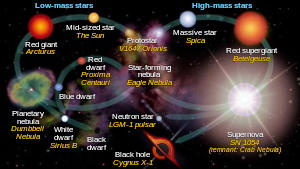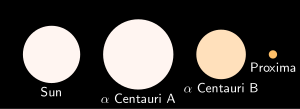Stellar Classification
This article "Stellar Classification" is from Wikipedia. The list of its authors can be seen in its historical. Articles copied from Draft Namespace on Wikipedia could be seen on the Draft Namespace of Wikipedia and not main one.
In astronomy, stellar classification is a way of grouping stars by temperature and luminosity. A star is a ball of superheated gas called plasma. Star temperature can be measured by looking at its spectrum, the type of light that the star shines. Stars are also grouped into spectral types or classes by color. In general, a star's temperature determines its color, from red to blue-white. Blue-white stars are the hottest, while Red ones are the coolest. Each class has their own subclass as well, with Hindu-Arabic Numerals. A G0 star would be the hottest type G and G9 with be the coolest type G.
Life Cycle of a Star[edit]

Stars are born in clouds of gas called a Nebula (plural: Nebulae) Nebulae are pulled together and become Protostars. Clouds of gas orbiting these stars then condense to form Planets, like how the Solar System was formed. The Star is then born and becomes a Main-Sequence Star. These stars live for up to 10 billion years and start to fuse hydrogen into the other elements of the Periodic Table. But as they reach heavier elements like Oxygen, they start cooling in temperature and become Red Giant stars, pushing their outer layers outward. Some stars expand even further into Red Supergiants by fusing metals. If the original post-giant star is more than 7 times larger than the Sun, then it will explode as a supernova for its death. Then it will become either a Neutron Star or a Black Hole, a bottomless pit that nothing can escape. If the original post-giant star is less than 7 times the size of the sun, it will become a white dwarf. White Dwarfs are small stars about the size of Earth, but they are hotter and were once the core of the progenitor star. Neutron Stars are the cores of original stars that have been crushed to the size of a city and they are packed up with Neutrons, the part of the atom that has no electrical charge. One 1 cm x 1 cm x 1 cm cube of their material would weigh as much as 5 fully-loaded cargo ships!
| Stellar evolution phase |
Temperature (Kelvin) |
Diameter (R☉, or other when specified) |
|---|---|---|
| Nebula | ~0 | 1 to 2,000 ly |
| Main Sequence Star | 3,000 to 50,000 | 0.08 to 20 |
| Red Giant | 3,000 to 5,000 | 20 to 200 |
| Red Supergiants | 200 to 2,600 | |
| White Dwarf | <4,000[1][2] to 150,000[3] | 8,000 to 100,000 km |
| Neutron Star | 600,000[4][5][6][7][8][9] | 5 to 50 km |
| Black Hole | 0.00000000000000000001 | Any |
Luminosity Class[edit]
Stars are also organized into another classification, this time for luminosity. This tells if the star is illegible to be called a dwarf, giant, supergiant, or hypergiant. It is also called the Yerkes spectral classification.
Temperature Class[edit]
The stellar classification used to classify stars by color or temperature has seven main classes and four other ones. It is called the Morgan-Keenan stellar classification. It was originally proposed by File:Flag of it.svg Italian astronomer Angelo Secchi, but has been improved by William Morgan and Philip Keenan.
Stellar Class
|
Secchi's original classification[10][11][12][13][14] | Temperature
(in Kelvin) |
Percentage (%) of known stars | Possible color appearance |
|---|---|---|---|---|
| LBV (luminous blue variable) | n/a | 7,500 to 50,000 | 0.000033 | 
|
O
|
30,000 to 50,000 | |||
| B | I (Orion subtype), V | 10,000 to 30,000 | 0.13 | 
|
| A | I | 7,500 to 10,000 | 0.7 | 
|
F
|
6,000 to 7,500 | 3 | 
| |
| G | II | 5,000 to 6,000 | 7 |  |
| K | 4,000 to 5,000 | 12.1 | 
| |
| M | III | 2,400 to 4,000 | 77 |  |
| Brown Dwarfs:[lower-alpha 1]
|
n/a | 200 to 3,000 | > 100 | |
Carbon Stars
|
IV | 1,000 to 3,000 | unknown | 
|
| Wolf-Rayet Stars | n/a | 30,000 to 200,000 | unknown | 
|
Hertzsprung-Russell Diagram[edit]
Star types are arranged in the Hertzsprung-Russell Diagram. This scattergraph was invented by File:Flag of dk.svg Danish and File:Flag of us.svg American astronomers Ejnar Hertzsprung and Henry Russell in 1908. Stars farther away on the right are cooler in temperature, while stars that are near the top are more luminous and bright.
B-V Color Index[edit]

In astronomy, the B-V color index is a numerical expression that determines the exact "color" of a certain star. The smaller the color index, the more the star appears blue. For comparison, our Sun has an approximate B-V color index of 0.656[15], while Rigel has a color index of -0.03.[16] Red Giants have color indexes from 0.81 to 1.4 .[17]
References[edit]
- http://adsabs.harvard.edu/abs/1981A&AS...46..193H
- http://adsabs.harvard.edu/abs/2001JRASC..95...32L
- http://adsabs.harvard.edu/abs/1994ASPC...60....3G
- https://www.aanda.org/articles/aa/abs/2008/37/aa09936-08/aa09936-08.html
- http://adsabs.harvard.edu/abs/2000A&A...353..163N
- http://www.annualreviews.org/doi/10.1146/annurev.astro.45.051806.110615
- https://www.cfa.harvard.edu/~pberlind/atlas/htmls/note.html
- ↑ http://adsabs.harvard.edu/abs/1997ApJ...489L.157H
- ↑ ISBN 0-333-75088-8
- ↑ http://adsabs.harvard.edu/abs/1999ApJS..121....1M
- ↑ http://www3.mpifr-bonn.mpg.de/staff/pfreire/NS_masses.html
- ↑ ISBN 1-61233-765-1
- ↑ http://imagine.gsfc.nasa.gov/docs/ask_astro/answers/010607a.html
- ↑ ISBN 0-387-33543-9
- ↑ https://heasarc.gsfc.nasa.gov/docs/xte/learning_center/ASM/ns.html
- ↑ A neutron star's density increases as its mass increases, and its radius decreases non-linearly. (archived image: https://web.archive.org/web/20111017230141/http://ixo.gsfc.nasa.gov/old_conx_pages/science/neutron_star/index.html) A newer page is here: https://heasarc.gsfc.nasa.gov/docs/xte/Greatest_Hits/khz.qpo.html (specifically the image https://heasarc.gsfc.nasa.gov/docs/xte/Greatest_Hits/cole.miller.plot.2.ps.gif)
- ↑ ISBN 0-521-25548-1
- ↑ http://gallica.bnf.fr/ark:/12148/bpt6k30204/f623.table
- ↑ http://gallica.bnf.fr/ark:/12148/bpt6k30204/f364.table
- ↑ pp. 62–63, Hearnshaw 1986.
- ↑ p. 60, Hearnshaw 1986.
- ↑ http://adsabs.harvard.edu/cgi-bin/nph-bib_query?bibcode=1992PASP..104.1035G&db_key=AST&data_type=HTML&format=&high=44b52c369023103
- ↑ http://simbad.u-strasbg.fr/sim-id.pl?protocol=html&Ident=Rigel&NbIdent=1&Radius=10&Radius.unit=arcmin&CooFrame=FK5&CooEpoch=2000&CooEqui=2000&output.max=all&o.catall=on&output.mesdisp=N&Bibyear1=1983&Bibyear2=2006&Frame1=FK5&Frame2=FK4&Frame3=G&Equi1=2000.0&Equi2=1950.0&Equi3=2000.0&Epoch1=2000.0&Epoch2=1950.0&Epoch3=2000.0
- ↑ ISBN 0-521-34787-4
Cite error: <ref> tags exist for a group named "lower-alpha", but no corresponding <references group="lower-alpha"/> tag was found
